Slip of the Tongue
Kathy Battista
November 2019
Curator Kathy Battista interviews artist Linda Cummings
 Liberty, Jersey City, N.J.
Liberty, Jersey City, N.J.
Kathy Battista: If we begin with the Slippages series, could you tell me more about the context in which you created these? What was going on in the world and where were you in your artistic development?
Linda Cummings: To me, art is something “slippery” that happens in the space between the artwork, the artist and the viewer. It’s a fluid interaction that moves between the human psyche and the world of experience, ideas, materials and events. For years I used slightly worn slips purchased at local thrift shops for inspiration in my art. I was drawn to their use as undergarments and the linguistic mutability of the word “slip”- as both noun, an object, and verb, something in transition. Their physical and metaphoric associations to skin and the slippery space between inside and outside experience, especially as it relates to gender identity, really appealed to me.
As a young artist I was attracted to the energy and engagement of social movements of the 1970’s: going to marches in Washington against the Vietnam war, marching for women’s rights to control our own bodies and protesting in anti-nuclear demonstrations which, for me was particularly relevant since I lived within a 50-mile radius of the nation’s first nuclear meltdown at Three Mile Island. I believe in the power of art to transform discontent into social or personal change and have always joined other artists in expressing my feelings and ideas through creative action. In 1991, however, watching the humiliating and outrageous televised parody of the “so-called” hearings of Anita Hill’s testimony against Clarence Thomas’s appointment to the Supreme Court, I began throwing things against the wall in my studio. I felt a sudden release watching the weight of my anger turn inside out and fly through the air. Shortly afterwards, I left the studio with seven slips I had been using in paintings and boarded a train headed for the desert in New Mexico to begin what became my ten-year long Slippages photographic project.
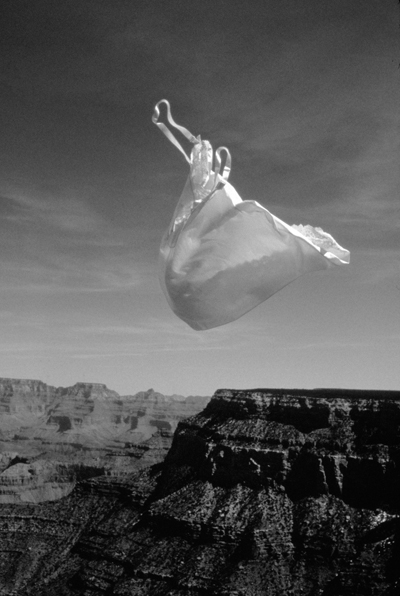 Chasm, Chaco Canyon, New Mexico
Chasm, Chaco Canyon, New Mexico
During the Reagan years, I moved to New York City from Pennsylvania, where I’d been working as an industrial photographer for Mack Trucks after graduating from art school in Nova Scotia. From early on I was interested in the psychology of perception. I did my first performative artwork, Pigeon-Holing in 1978 in a public park in Halifax, Nova Scotia by constructing pinhole cameras in the size and shape of pigeons in order to photograph live pigeons from the vantage point of my decoy cameras. Pigeon Holing began my life-long creative engagement with questions of perception and recognition, dynamics of memory and identity and curiosity of how one’s view of the world is constructed. I feel the Slippages is an extension of that interest in another context.
A few other things come to mind regarding the slip- namely, my conscious choice not to use my own personal body, but instead find a metaphor for gendered bodies in general, in transition – lost by one and found by another, as were the found objects of Surrealism, Fluxus and Happenings. The tossed slip is a visual puzzle or pun – a liberatory or casting off (rejecting) gesture – both letting go and holding on, rising or falling. Nude Descending the Staircase I is a nod to Duchamp’s 3 Standard Stoppages (1913 – 14) where pieces of cut string were tossed and traced where they landed.
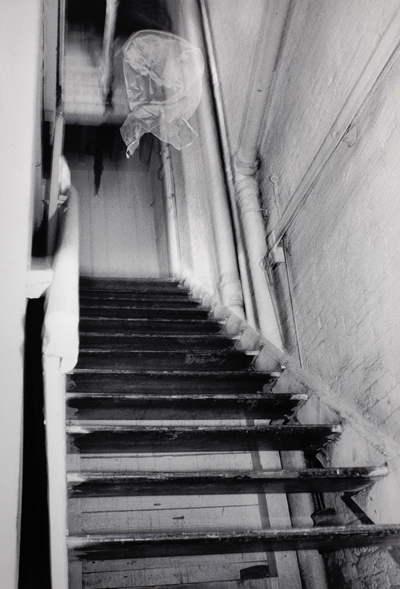 Nude Descending the Staircase I, Brooklyn, N.Y.
Nude Descending the Staircase I, Brooklyn, N.Y.
The relevance of the slip in the air, transformed, transfigured, and mutated in the sky ia a reference to Space as a feminist domain – a place still open and unnamed – a place of possibility, mutability, transition and uncertainty…a space in-between, a place to claim and belong and appear – a place I could exist – especially when defying the laws of society or gravity. The photographic act itself creates a radical rendering of reality, defying nature by defying time and space – extracting a “slice” of appearances – collapsing space – freezing a moment in time.
KB: I’m interested that you wanted the slips to have been worn/inhabited because you could have bought brand new slips.
LC: A brand new slip would have suggested a mass-produced and untouched garment, something general and removed from an actual human body. A previously worn slip is specific, imbued with the stains and tears of a life. Choosing a worn slip focused on what’s left behind, a life already lived – an archeology of embodied knowledge that can’t be erased. I like the slippage between visibility and invisibility, perception and recognition, the forgotten, the life of something only visible in a trace or glimpse.
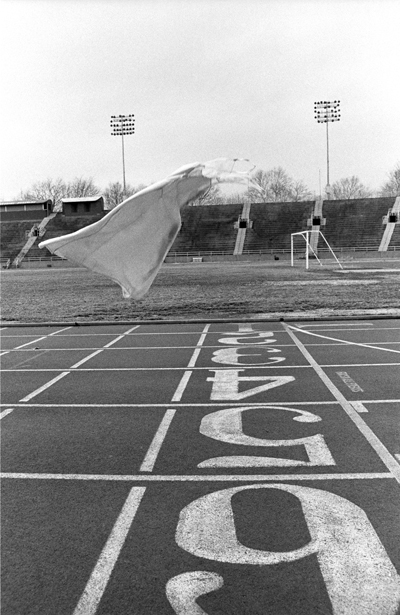 Disintegrator, Randall’s Island, N.Y.C.
Disintegrator, Randall’s Island, N.Y.C.
KB: Could you speak about why you chose to use black and white film for this series?
LC: I came out of a long tradition of black and white photography. My earliest yearnings in photography were with experimental photography in the years between WWI and WWII – the 1920’s – people like Man Ray and even Rodchenko and the constructivists in Russia, and the dynamism of the Futurists (although I hated their politics). At that time most were black and white photographers – color was a new frontier. That was a time of great upheaval in the western world, not unlike today. Old forms of knowledge and meaning were being challenged and reshaped by technology and geo-politics and reflected in art – Cubism, Dada, Surrealism. I found color gave photographs a lot of energy and emotion, but that was not my intention. I was interested in the structures, lines and shapes and movement within the image and my intention was mostly conceptual. As such, it seemed really important that the photographs be black and white. When I began working at Mack Trucks I found myself drawn to the tradition of the FSA photographers of the 30’s and 40’s – such as Walker Evans, Dorothea Lange, and the idea that photography could be used as a way to change the way people see things socially, not just perceptually.
KB: Did you experiment with color film?
LC: Yes, at Mack Trucks, Inc. I learned a lot about color but it was mostly a black & white world I lived in – on lots of levels. Early on I struggled for visibility and a voice through my art, creating visual poems of resistance using photo collage and hand-coloring, like the Machine Dream series. Today I see the connection between that early work and my slip photographs. They all have a common thread in this conceptual and metaphoric dance between presence and absence, tension and release, and the struggles inherent in times of personal upheaval and collective or social change.
KB: I guess you had to take a lot of shots to get the right one.
LC: Yes, and a lot of patience! For every roll of film, maybe one or two would make the cut. Toward the middle of the 1990s, I began putting copper thread along the hem and the seams so the slip could open more and hopefully yield more good shots. I also chose slips because of their color and reflectivity and amount of lace depending on what was happening with the wind and light and color of the sky. They all had character!
KB: At this point you’re still shooting on film?
LC: Oh yes, I shot film the entire slip series on 35 mm rolls of film.
KB: So you had to get it developed to see the results?
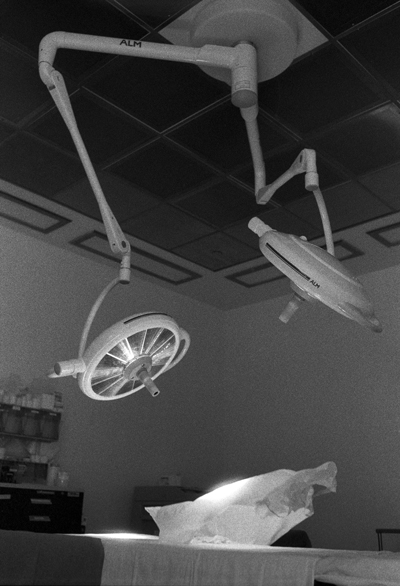 Operating Theater I, St. Vincent’s Hospital, N.Y.C.
Operating Theater I, St. Vincent’s Hospital, N.Y.C.
LC: Right, and that was a big piece of it. I love the interaction between knowing and not knowing what will happen in the viewfinder and in the darkroom. I did not know what I had captured until I got back to my lab and could process the film. None of these are digitally, or in any way, manipulated. These are all on-site images that were created in the moment, with me just holding the camera and responding to the arc of the slip in relation to everything else. So it became a choreography, an experiment between me and forces larger than myself–whether they were socio-cultural forces, or environmental forces like light and wind and landscape – or psychic, unconscious forces inside me.
KB: It connects to the water works because you have this short window of opportunity, and there’s a high risk for failure.
LC: Yes. Failure is a really big part of what I negotiate with, as well as uncertainty and surprise. I like that. That’s what I mean by unconscious forces. I like being in that small window because it opens out into a big field of possibility. I like engaging with failure as a motivation to keep working until I have this internal feeling that what I have done is enough and what I have engaged is honest. My impulse is largely about engagement in the moment, on site, with all of these elements, giving form to the experience of the reciprocal nature of perception. Each of us participates in the co-construction of our own reality. So many times it is just an audience of one that I am performing for, and it is me. That is a little bit different than a performance artist who is performing for a group.
KB: And you had no assistant?
LC: Occasionally, but not in the beginning. At the very beginning when I was in the Hopi tribal lands in Chaco Canyon I didn’t have an assistant, but as I went on, beginning with the New Orleans series in the St. Louis Cemetery, I asked friends or family members to come help me. So yes, then one other person was standing off frame. I wanted the photographs to have an air of mystery and intrigue and ask questions of the viewer. What is this form? Why is it here and what is the story behind it? Who is the invisible actor? What is being enacted and why?
KB: And when you inserted the slip into an industrial situation like the factory, were you thinking of the Bechers?
LC: No, I actually was not aware of the Bechers in the early 1990’s. As I became aware of the Bechers I was really interested in their work but soon realized our work looked similar but had different intentions. Mine was both a celebration and mourning about how gender relations and technology were reshaping what was possible. I wanted to photograph transitional spaces. Bethlehem Steel was in the process at that point in the mid 1990s of folding and being dismantled and being shipped to India. I wanted to highlight, maybe conflate, the fact of technology shaping and reshaping our physical environment with notions of gender shaping and reshaping our social and emotional environment. So to position the slip within the context of this changing technological landscape was also to posit that gender relations were adrift and had been ever since women won the right to vote in 1920.
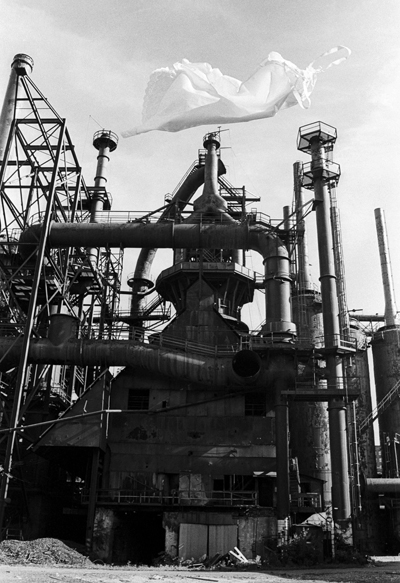 Exchange Values, Bethlehem Steel, Bethlehem, PA.
Exchange Values, Bethlehem Steel, Bethlehem, PA.
KB: Even the semiotics of the slip at Bethlehem steel–the dark against the white. Also, it looks like that slip is at the top of the building, but that must be due to the angle of the camera?
LC: Yes, it is perspectival space, and I was thinking of how the myopic point of view of the single lens reflex camera actually reinforces the one-point perspective that characterizes most forms of totalitarian thought.
The Bechers, coming out of post WWII Germany, knew a lot about how the structures which a culture builds reflect the socio-economic and technological needs, and the consciousness of their time. Without knowing their work, I was making a similar observation with my photographs, but in perhaps a more personal and playful way.
KB: Becher with an intervention.
LC: Yes, with an intervention. My Slippages were as much an homage to Mary Kelly and her “hysterical gestures” project as to the chance operations and playfulness of Duchamp and Man Ray.
KB: Yes, I didn’t think of the Slippages – Stoppages linguistic relationship. That is important. So for each location, there is just one image that represents it? You had to edit it?
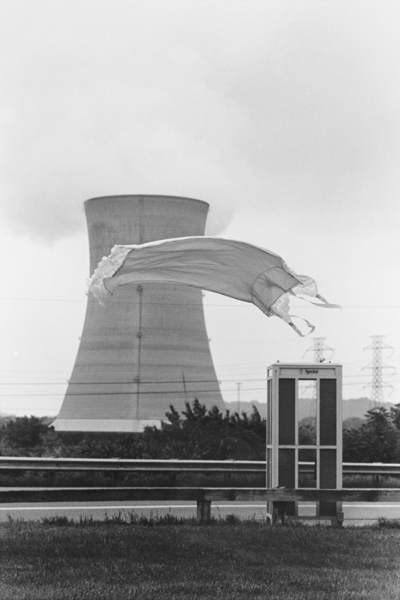 9-1-1, Three Mile Island, Middletown, PA.
9-1-1, Three Mile Island, Middletown, PA.
LC: No, I would shoot maybe 80-100 images in each location, depending how much time I could take before being caught or kicked out. Then for each portfolio, I’d edit it down to probably around 8-10 or maybe a few more..
KB: So each location has 8-10 images in this series?
LC: Yes, but a series may constitute one central, or it might include adjacent, locations. For example I have a series called Steel City taken in Bethlehem, PA. but it also includes abandoned coal mines in Hazeldon, PA that were feeding coal to the steel mill. For example, White Flame was taken in the mine and the photograph right next to it; Exchange Values, was made outside the steel mill.
KB: I didn’t know mines had windows and clocks.
LC: They do, but that is actually not a clock. It’s a coal breaker, and they are above ground. Once the coal is excavated from the mine, from the earth, it is funneled into these big machines and then cut, or crushed into different sizes, or grades, of coal. In this series I was paying homage somewhat to Lewis Hine and the invisible labor that goes into the production of coal and mining, and all our goods and services. The slip is a ghost-like trace of the invisible, unnamed and underpaid workers to whom the world turns a blind eye.
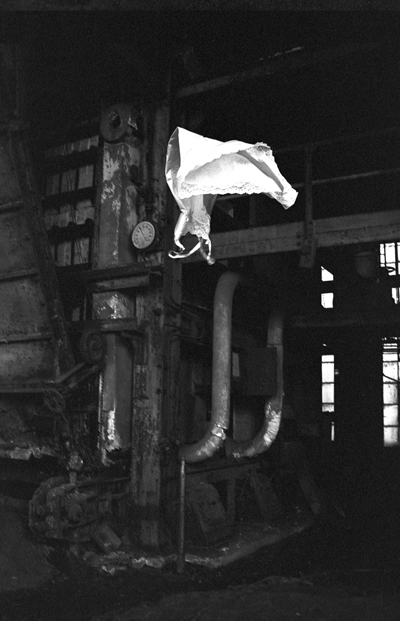 White Flame, Abandoned Coal Mine, Hazeldon, PA.
White Flame, Abandoned Coal Mine, Hazeldon, PA.
KB? How difficult was it to get access to these sites?
LC: Getting permission for access to most sites was tricky, difficult, sometimes dangerous, and occasionally impossible. I used guerrilla tactics, meaning enter first and ask permission when stopped. I often had to trespass. I took a lot of chances, which was part of the larger weave of engaging uncertainty. If I wanted to engage a particular institution or cultural sphere, like the stadium or the hospitals, yes – I had to get permission. The stadiums took the longest – often up to three months to get permission. And permission was targeted and circumscribed. I had to agree to photograph within a very short window of time, at a particular day, rain or shine, and be accompanied with up to three security personnel watching my every move. So imagine with each of these photographs in the stadium, the Ovulator series, there are three big guys just barely off-frame, making wise cracks about women and balls and slips while I am working.
In the Name of the Daughter was taken inside the Cathedral of St. John the Divine in New York City. It is a very large cathedral so my assistant and I had to work quickly and dart in and out between the pillars and chapels without being noticed. But in St Patrick’s Cathedral on Fifth Avenue I was stopped by a security guard who asked me to surrender my film, which I did. Little did he know, tho, that I had learned from previous encounters to always take 2-3 extra rolls of unexposed film to hand over if necessary.
Sometimes I encountered willing participants, like at the Bethlehem Steel plant. Deciding my best strategy was to show up at 6 am on a Sunday morning in a neglected yard at the mill, I was shooting outside for almost an hour before two workers who had been spying on me approached and asked what I thought I was doing. Fortunately for me, they were bored and curious with their jobs as night watchmen and I was able to enlist them in my playful escapades. They ended up helping me gain access to the interior of the plant, where I made many images, including Belly of the Beast. I was really grateful for their sense of adventure and sent them pictures afterwards.
KB: Can you speak about the relationship between painting and photography in your work? I’m thinking in particular of series such as Substance of Light or Pharos.
Pharos engages the wind in the making of a photograph. It actually connects with the choreographic way I work as a photographer, with the Slippages series, but also goes back to the collages I did in the early 80’s, like the Machine Dream series. I am still inventing new ways of working to liberate my hand and eye from the constraints of the machine. So, I first make a “plein-air” drawing with lead, silver and a surgeon’s knife, inviting the wind to open its surface, transforming the shape of the drawing into a dimensional expression of the interacting forces at play. When the resulting image is successful, it provides a point of entry into a potential space where materiality and possibility co-exist. For me, this is the liminal space of art and it becomes the jumping off point for the photographs to emerge.
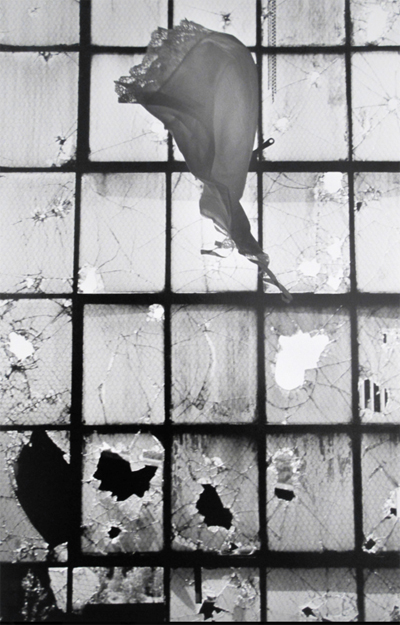 Shattered, Bethlehem Steel, Bethlehem, PA.
Shattered, Bethlehem Steel, Bethlehem, PA.
My current work and its relationship to the semiotics of photography and drawing is an important link between the evolution of my creative practice. My focus has shifted from the human body to a body of water and wind. Slips, now of paper, and marks made by hand depict traces of my human contact and the reciprocal relationship between seeing and scene. The new work invokes the darkroom experience while allowing me to be both participant and observer, shaper and shaped, in a choreography of collaboration with forces both within and beyond my control – like the tides, gravity, light and wind.
KB: Does the current political climate feed into your work?
LC: Yes, very much. It always has. Artists feed on what both our brain and all of our senses supply. Being sensitive to what’s happening and finding a way to give form to those feelings is how I make art. In 2016, prior to the election of Donald Trump, I staged a series of performances of Miss-ery for Democracy Pageants in NYC, in public spaces to voice my outrage over his candidacy.
For better and worse, I can’t turn off my senses, or I lose contact with my art. Artists are canaries in the coal mine. We know our species is speeding recklessly toward oblivion, on a collision course with ourselves and with nature. As we all barrel into the future, I am driven to look deeper into my relationship with nature as a source of inspiration and point of departure for my creative work. Probably my most directly political work was my 24 Frames scroll series after the Invasion of Iraq in 2003. I made these really long scrolls standing in one spot in Times Square outside the US Army Recruiting Station, rotating in a circle, photographing everything going on in the streets and on the billboards for 24 minutes. Then I’d go to demonstrations carrying my photographic scrolls, like Body Boys.
Anniversaries are important because they are markers of change. In 1997 I created the Ovulator Baseball Card series, on the 25th anniversary of the passage of Title IX of the Education Amendment prohibiting sex discrimination in sports education in all schools getting Federal Aid. The project consisted of a series of six fictional baseball players, all female, with brief vignettes about their ties to the sport on the back, along with real “stats” of women in sports that year. I gave them to young female fans in Yankee stadium that summer.
Next year, 2020, is the 100th anniversary of the passage of the 19th Amendment to the Constitution, giving women the right to vote. It is fitting for me to take this moment, now, to re-introduce my Slippages series to a new audience. In a newly curated portfolio I combine vintage Slippages prints with newly printed photographs from the original Slippages negatives, made in the 1990’s. This newly assembled portfolio of photographs, Revisiting Slippages (2020 Edition) bears witness to the impact of “gender trouble” (to use Judith Butler’s term) at the end of the first century in which women’s voice and vote began re-shaping the world.
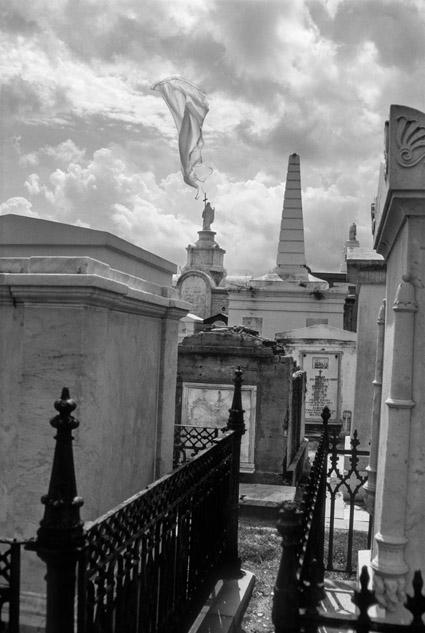 Slip of the Tongue, St. Louis Cemetery, New Orleans, LA.
Slip of the Tongue, St. Louis Cemetery, New Orleans, LA.
◊
Kathy Battista is scholar, lecturer, and a curator of exhibitions in museums and galleries, most recently, The Art of Fashion at Fountain House Gallery New York, Escape Attempts at Shulamit Nazarian Gallery, Los Angeles, and E.A.T.: Experiments in Art and Technology at the Museum der Moderne, Salzburg, Austria. She has authored numerous articles and books, including: New York New Wave: The Legacy of Feminist Art in Emerging Practice and Renegotiating the Body: Feminist Art in 1970s London. Battista is currently co-editing (with NY faculty Bryan Faller) a forthcoming book on artist estates and foundations, Creative Legacies: Critical Issues in Artist Estates, for Lund Humphries available April 2020.
Linda Cummings
Revisiting Slippages : A defiance of gendered divisions
Project Portfolio →
